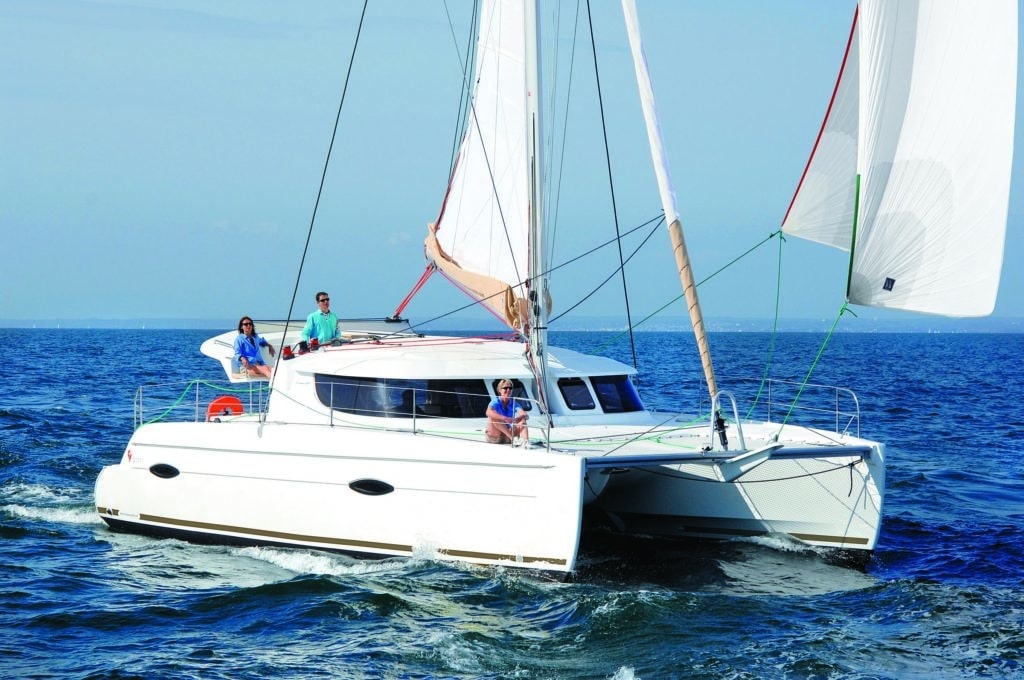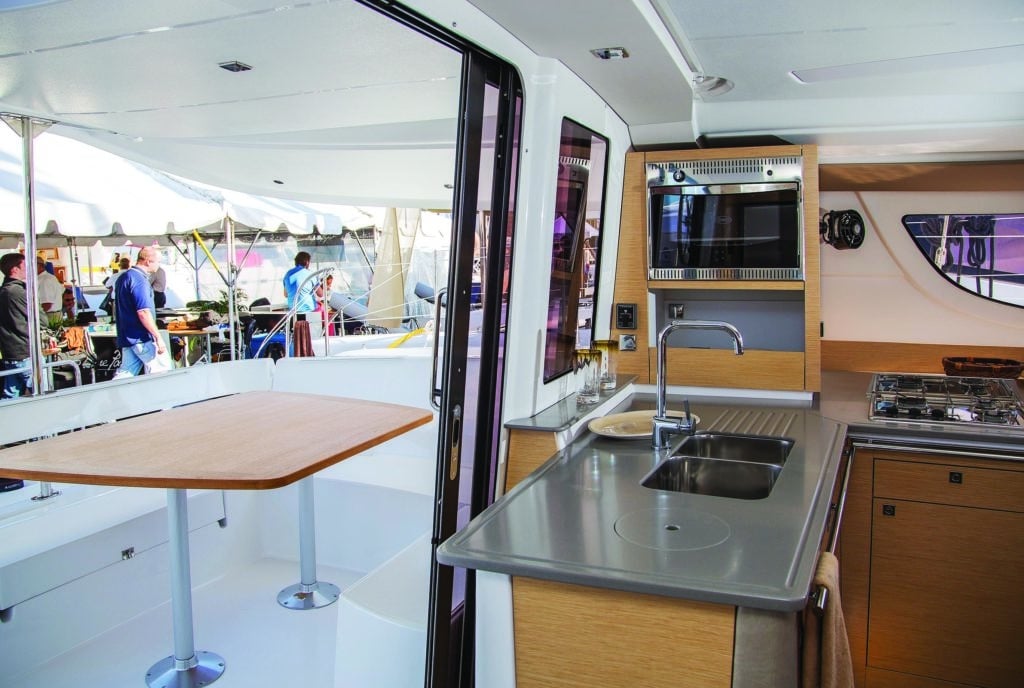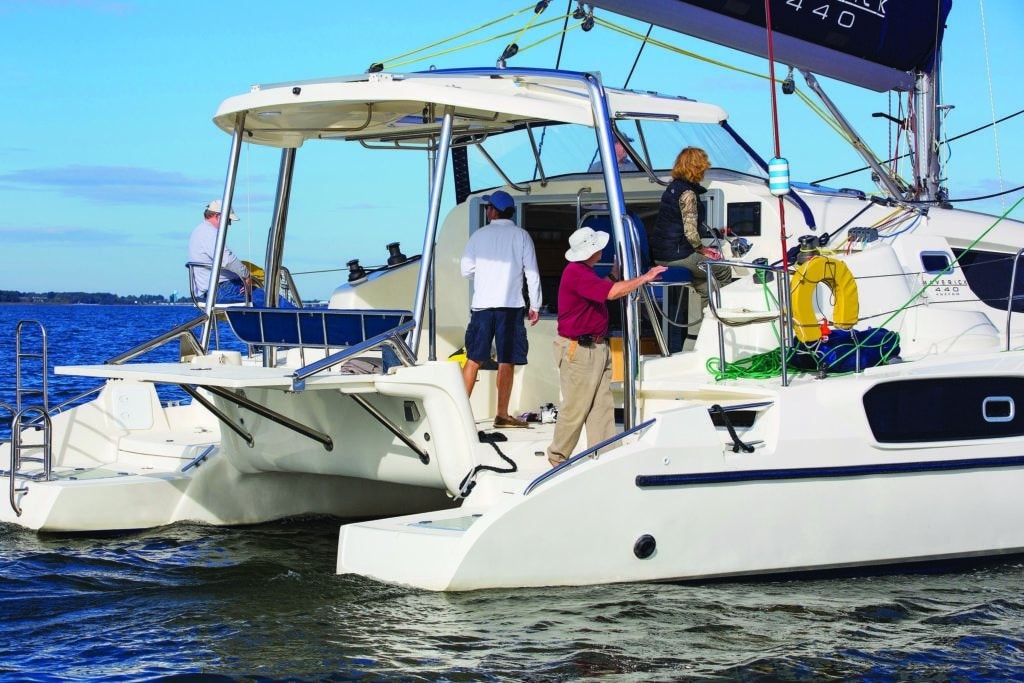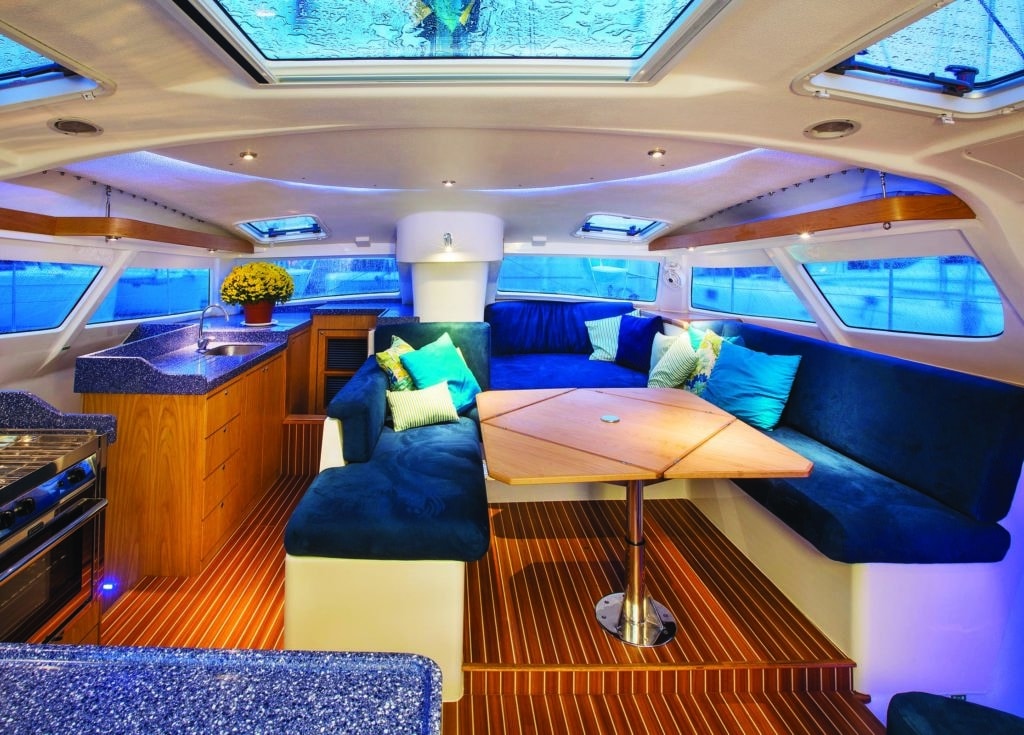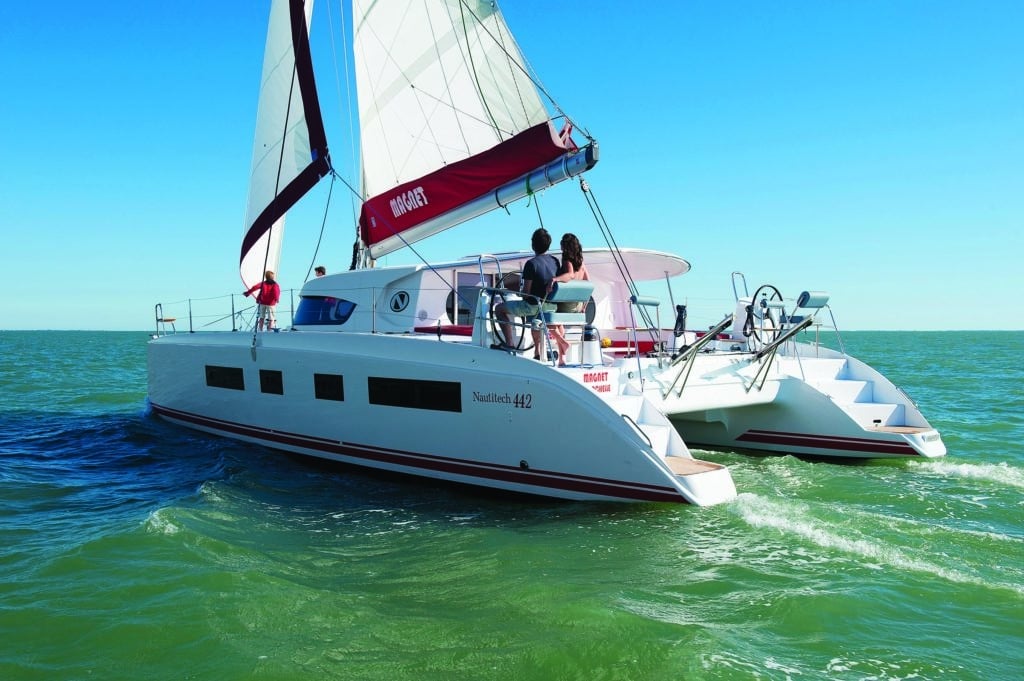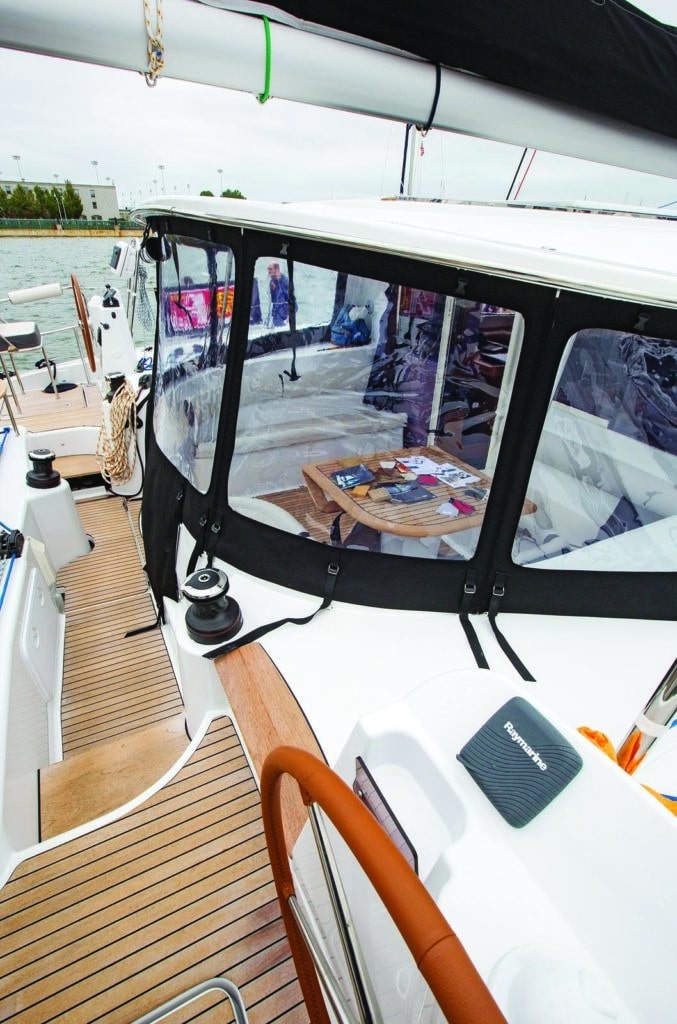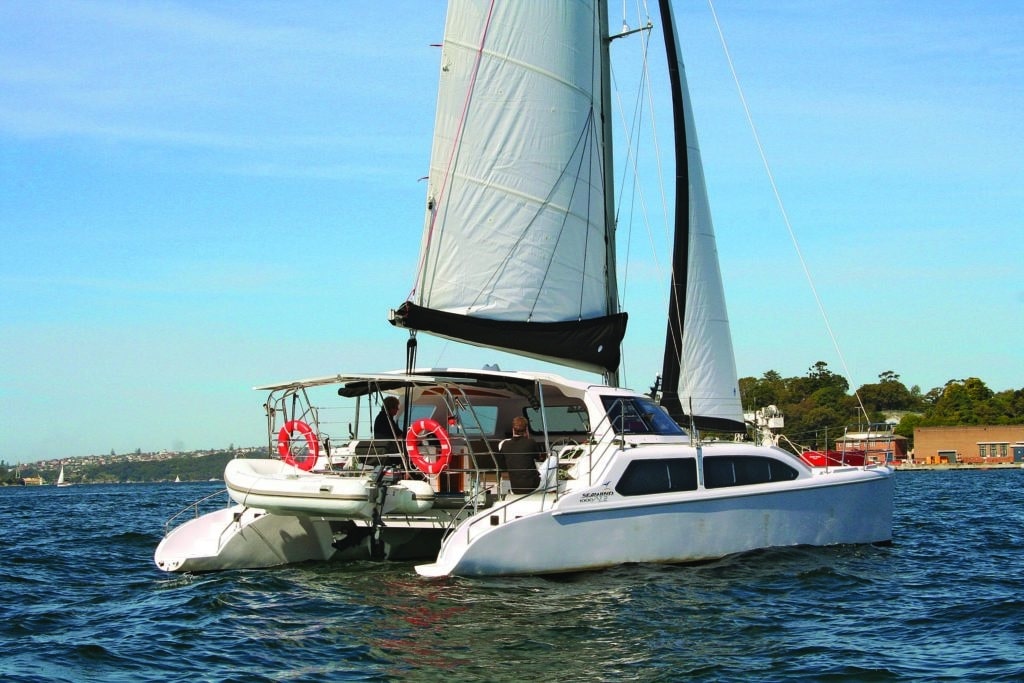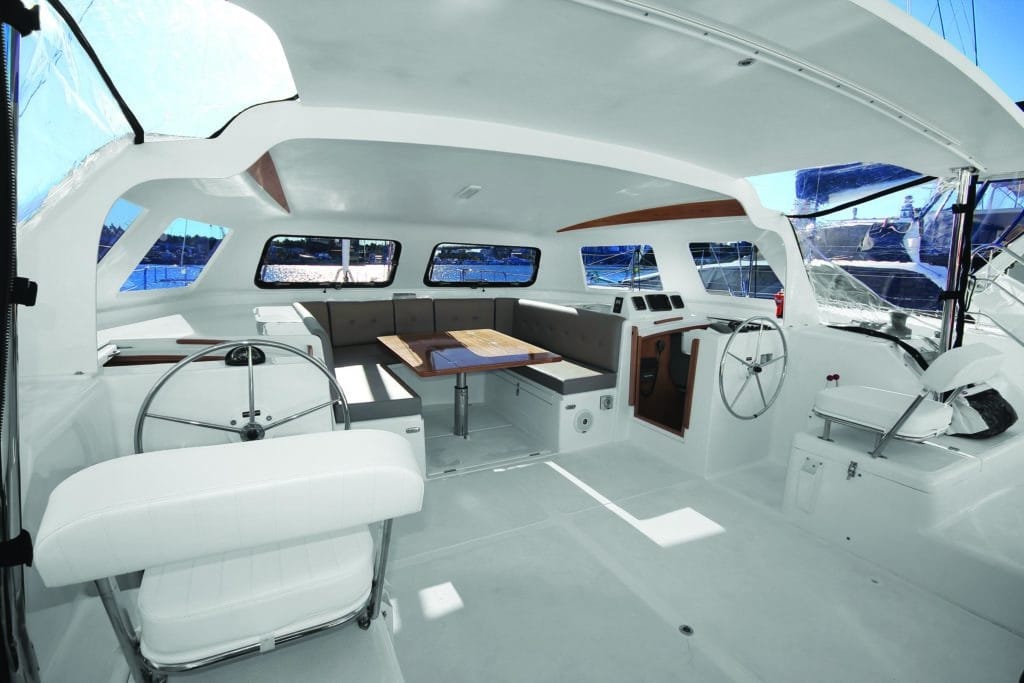Along with the new sailboats that make their debut each year, there are often models that get reintroduced by a builder. These boats are usually popular models to begin with that have undergone significant upgrades that take advantage of new building materials or changes based on buyer feedback or industry trends. The end result can feel like a very new boat indeed.
During the U.S. Sailboat Show in Annapolis, Maryland, last fall, I had the opportunity to check out four such boats, all catamarans. I was impressed by the thought that each builder put into improvements large and small, to enhance both under-way performance and liveaboard comfort.
Lipari 41 Evolution
The Lipari 41 Evolution by French manufacturer Fountaine Pajot builds upon the original Lipari, which was released in 2010, by focusing on livability. The most notable changes center around the galley and cockpit, and designers Joubert-Nivelt have packed impressive creature comforts and storage space into a cat with an LOA of just under 40 feet. Part of what makes cruising a cat special is the one-level living space between the cockpit and the saloon. The Evolution emphasizes this by making the doorway between the two larger, opening the galley directly to the cockpit for easy entertaining and adding a new sofa in the cockpit. The elevated helm seat, which can comfortably fit two, is integrated into the composite bimini and coachroof, creating a smooth line visually. Access to the boom has also been improved. “To me, the new Lipari 41 Evolution reflects the lines of the Hélia 44 and also benefits from the new, contemporary design of the range,” says Hélène de Fontainieu, director of marketing for Fountaine Pajot. “With the new cockpit and galley, the boat was very well received at both the Annapolis and Miami boat shows.”
Along with 360-degree views and larger opening hatches, the bright saloon features a large table that can seat eight and a new forward-facing chart table. The galley features new synthetic-resin countertops and an updated drawer-style refrigerator.
In the aft cabins, redesigned opening ports have improved the natural light and ventilation. The blond oak woodwork further enhances the bright look of both the saloon and the cabins. The Lipari 41 Evolution is offered in two versions: The Quatuor has four cabins and two heads, and would be well suited for family cruising or chartering. The Maestro turns the entire starboard hull into an owners cabin with en suite head, a queen-size bed and a desk; the port hull remains the same.
Maverick 440
Building on the successful (and still available) Maverick 400, the Maverick 440 uses the same hull mold as the 400, but the transoms are extended an additional 4 feet, providing room for spacious swim platforms, increased buoyancy aft and better boat speed.
Both the 400 and 440 are built in South Africa and are made for shorthanded bluewater cruising. They have wider hulls than you typically see on cats, which provide more interior volume and load-carrying capacity. Builders Rudi and Deslynn Pretorius intend the Mavericks to be go-anywhere boats for couples who don’t want to sacrifice any of the comforts of home. An interesting feature on the 440 is the extra berth area in the saloon, forward of the dinette. I thought it would serve as a great bunk for night watches or as a place for kids to hang out. “I am extremely happy with the outcome of the 440,” says Rudi Pretorius. “The extra area on the transom allows so much more space, usability and safety. The sailing performance has increased by almost a knot, and the motion is much smoother with less hobby-horsing. We are currently building the fifth Maverick 440.”
When drawing the original Maverick 400, designer Phil Southwell set out to improve the interior flow and space found on most cats, while keeping the boat a manageable size for two people. Since the boat is designed for a couple, the Maverick 440 has a standard three-cabin layout with a sizable master stateroom and en suite head to starboard, and two guest cabins and a midship head to port. As a semi-custom builder, Maverick will also work with owners to fit out the boat with the layout and materials of their choice.
Nautitech 442
Both the Nautitech 442 and its sister ship, the 441, evolved from the successful Nautitech 44. Designed by Marc Lombard and built in Rochefort, France, the 442 features dual helms that are outboard and aft, offering excellent visibility forward and steering redundancy (the 441 has a single, elevated helm at the aft bulkhead). A theme I’ve noticed over the past few years on both multihulls and monohulls is better integration of indoor and outdoor spaces aboard. On the 442, the new, larger portholes give the exterior a more modern look in addition to providing more light in the hulls. An improved sliding door enhances access between the saloon and cockpit.
Nautitech uses a resin-infused sandwich hull construction above the waterline and solid laminate below, resulting in a stiff, well-insulated hull. Furniture and hull stringers are also foam cored, further increasing weight savings.
For long-term cruising, the coachroof is an excellent place for a solar array, and it also has a clever rainwater catchment system — the roof is slightly curved and water is channeled into a designated 400-liter tank that also incorporates an automatic or manual salinity tester.
Seawind 1000XL2
Why start from scratch when you have a good thing going? The Seawind 1000 was originally launched in 1994 and had a very successful run. In 2008, the company debuted the 1000XL, which extended the transoms a little over 2½ feet, improving performance and stability. The latest transformation of this popular cat is the 1000XL2, and it packs in a host of upgrades.
Seawind, an Australian company, acquired the performance trimaran builder Corsair Marine in 2010, and the 1000XL2 is produced in Corsair’s factory in Vietnam. This facility uses vacuum-bag technology during layup, which, compared with the 1000XL, shaved 1,100 pounds from the displacement. The fiberglass finish work is also improved. “With the merger of Seawind and Corsair and the boats now being built in Corsair’s factory, the processes used in keeping the trimarans lightweight over the years have been transferred to the catamaran production line,” says Kurt Jerman, president of West Coast Multihulls, a U.S. distributor for Seawind Catamarans.
The new extended hardtop bimini provides better shade for both the helm and the interior. “One of the most visible changes with the XL2 is the hardtop extension. It allows the owner to walk the full length of the boom and easily deal with the mainsail cover, which is easy to unzip to get going and then zip up at the end of the day,” says Jerman. “The fully battened mainsail with ball-bearing cars on the mast makes for a really nice system when handling the main.”
Shorthanded crews will also appreciate the new push-button controls for the electric tilt on the outboards, and an improved electronics console that is easily visible from the helm and made especially for Raymarine’s new eSeries instruments.
The 1000XL2 also has upgrades in the saloon, including a new hardwood folding table that can be lowered to make up an additional bunk, and a clever sliding hatch over the galley, in the starboard hull. The opening increases ventilation and provides a convenient pass-through for galley items heading to the saloon table. In the galley, you’ll also find new cabinetry and an updated range.
Manufacturers:
Fountaine Pajot, www.fountaine-pajot.com
Maverick Yachts, www.maverickyachts.co.za
Nautitech Catamarans, www.nautitech.fr
Seawind Catamarans, www.seawindcats.com
Jen Brett is CW’s associate editor. This article first appeared in Cruising World, June 2014.
